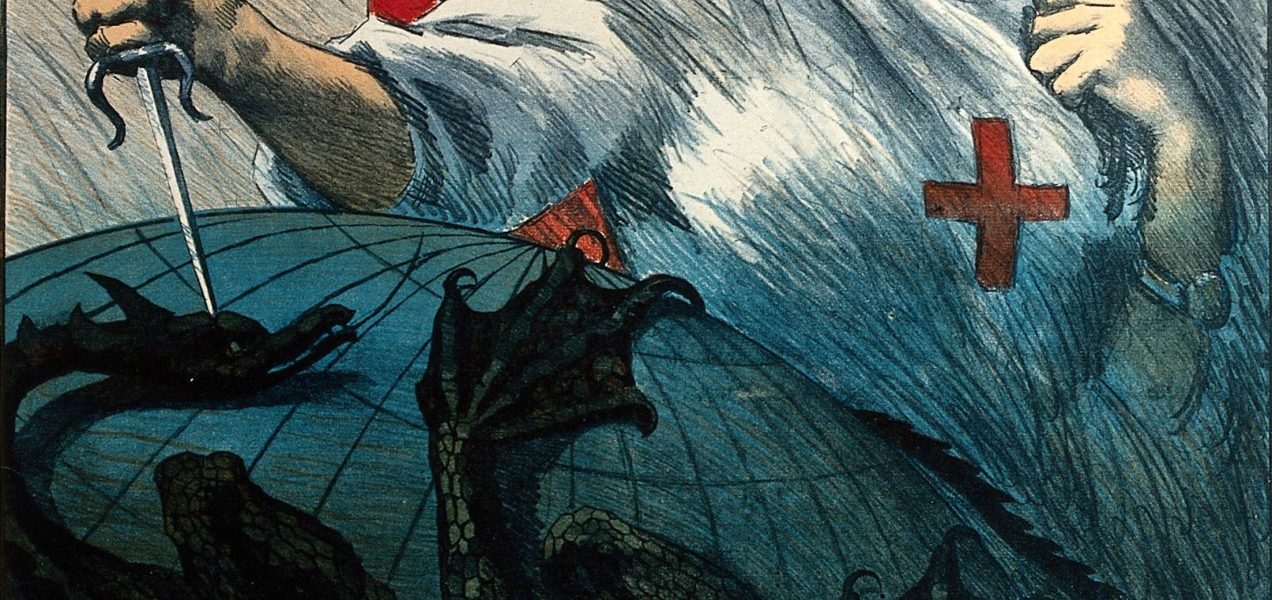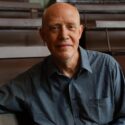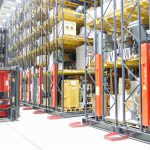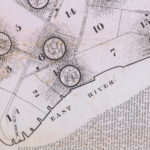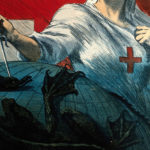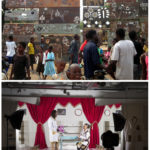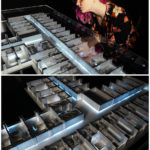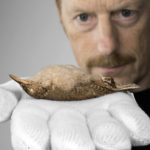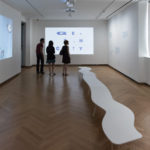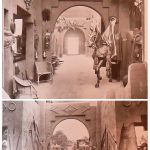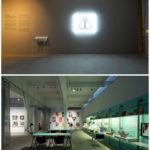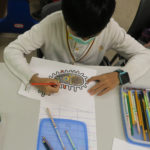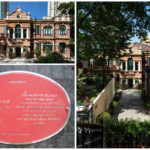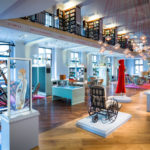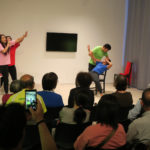Contagious Cities: an international collaborative enquiry
Article DOI: https://dx.doi.org/10.15180/201405
Abstract
Contagious Cities was a cultural project that explored how urban environments in different parts of the world have coped with infectious diseases. Its theme of how populations prepare for and deal with epidemics is a core strategic concern for Wellcome – the large health and medicine foundation behind the project. Thoroughly interdisciplinary in their approach, the variety of exhibitions, events and other cultural activities the project supported placed a special emphasis on the illuminating potential for artists to investigate medical, scientific and social phenomena. The initiative also drew inspiration from Wellcome’s track record of curating interdisciplinary projects in its own museum in London, and approached its international ambitions (in Geneva, New York, Hong Kong and Berlin) through partnership and co-production. This article looks back at this unusual project, which ironically was concluded just before the world plunged into the current pandemic. The emphasis here, however, is somewhat less on the project’s themes – the fascinating and frightening implications of human co-existence with microbes in crowded contexts. Instead, we have focused on the complexities of working with multiple stakeholders in very different contexts, and we reflect on Wellcome’s role as an experienced, knowledgeable and creative, but also powerful and well-funded partner cum commissioner.
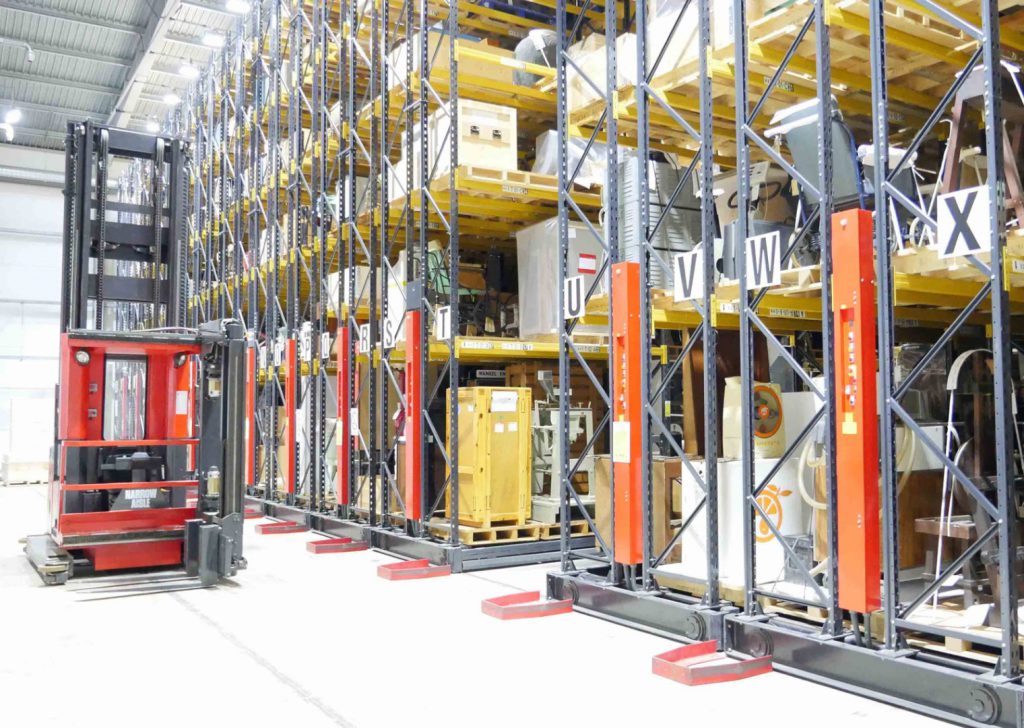
Keywords
artistic enquiry, co-production, culture and cause, epidemic preparedness, fellow enquiry, interactive storytelling, outputs and outcomes
Introduction and themes
https://dx.doi.org/10.15180/201405/002A century ago, the world was just emerging from one of the deadliest human pandemics. Sometimes called ‘Spanish Flu’, it killed an estimated fifty million people, infected ten times that number, and touched the entire globe’s population. Thankfully, the statistics from COVID-19 look set to be a small fraction of that; but we too are realising that it will, somehow, affect everyone alive. Wellcome’s international cultural project Contagious Cities (2018–2019) – a network of exhibitions, events and other outputs – was timed to mark the hundredth anniversary of a disease tragedy that is still remarkably under-recognised and discussed. While epidemiologists have long asserted that future epidemics were as good as inevitable, it has nevertheless been extraordinary, as well as frightening, to witness the project’s core theme of epidemic preparedness get catapulted from the agendas of niche experts to become, for a while at least, the world’s most vital topic.
Humans inhabit cities, just as bacteria and viruses inhabit us. This intimate connectedness mostly plays out across a web of benign and managed co-dependencies. Sometimes deadly diseases emerge as predictable, if not inevitable, destructive consequences of that entanglement. At the core of our investigative initiative – one which placed special emphasis on juxtaposing insights for science and medicine with others from humanities and arts – were the hinged questions of how cities and diseases shape each other: how city life enables infections to spread but also to be understood and quelled; and how those histories leave their traces in the fabrics of cities.
Contagious Cities was rooted in specific, local details of archive, fact, exhibit and story; but it also expanded across broader issues. Time and again, it showed – as COVID-19 is currently throwing into sharp relief again – how the best and worst of human behaviour can emerge simultaneously: how insight, innovation, compassion and hope are just as infectious as fear, despair, anger and hopelessness. And how all of these factors influence economic activity and confidence.
In mid-nineteenth-century New York, for example, the prevalence of cholera in poorer neighbourhoods was vehemently held by some to be clear evidence of moral depravity, with the resulting deaths seen as a predictable and just consequence. But for others, it gave extra urgency to efforts at managing public health measures like the provision of fresh water and the removal of farm animals from the city, which eventually contributed to declining outbreaks of the disease. (See Germ City website.)
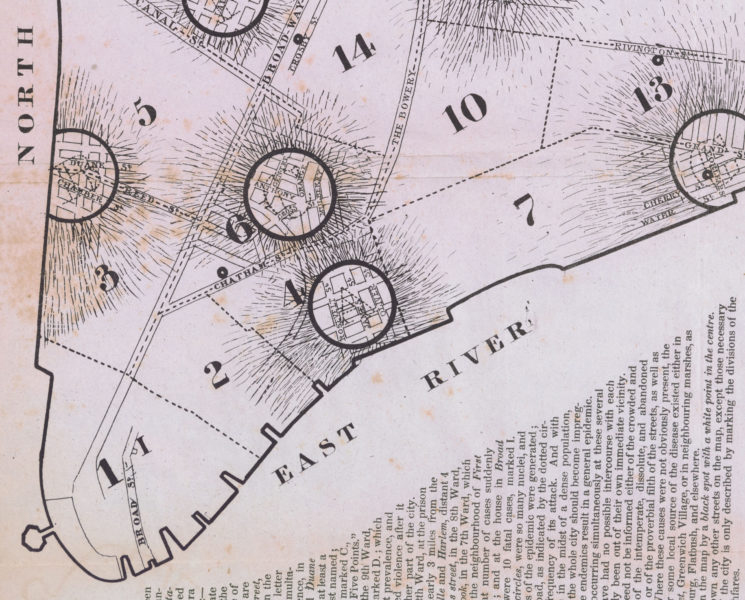
David Meredith Reese, A Plain and practical treatise on the epidemic cholera, as it prevailed in the city of New York, in the summer of 1832 (detail), 1833
© Stanford University LibrariesDetails like these, and so many more disease episodes explored through each of Contagious Cities exhibitions and events, repeatedly revealed just how thoroughly medicine is intertwined with its social contexts in any given geography: how societies of all sorts desperately need science; but also, how much science relies on those diverse societies. Questions of language were also ubiquitous, surfacing, for example, in the all-too-tempting instinct to find a group somewhere to blame: ‘Spanish Flu’ (for the 1918 flu pandemic); the ‘French’ or ‘Italian’ or ‘Christian Disease’ (for syphilis); ‘Gay Related Immune Deficiency’ (for HIV/AIDS).
At a deeper level, the project also exposed how much words and worldviews go hand in hand. Mariam Ghani, for example, one of the principal artists commissioned for the project, explored dominant metaphors for infectious illnesses through her film Dis-Ease. Stitching together a wealth of archival visual and narrative material, as well as institutional resources, Ghani’s film builds a compelling meta-narrative of diseases that draws out noticeably dominant social fears and political assumptions.
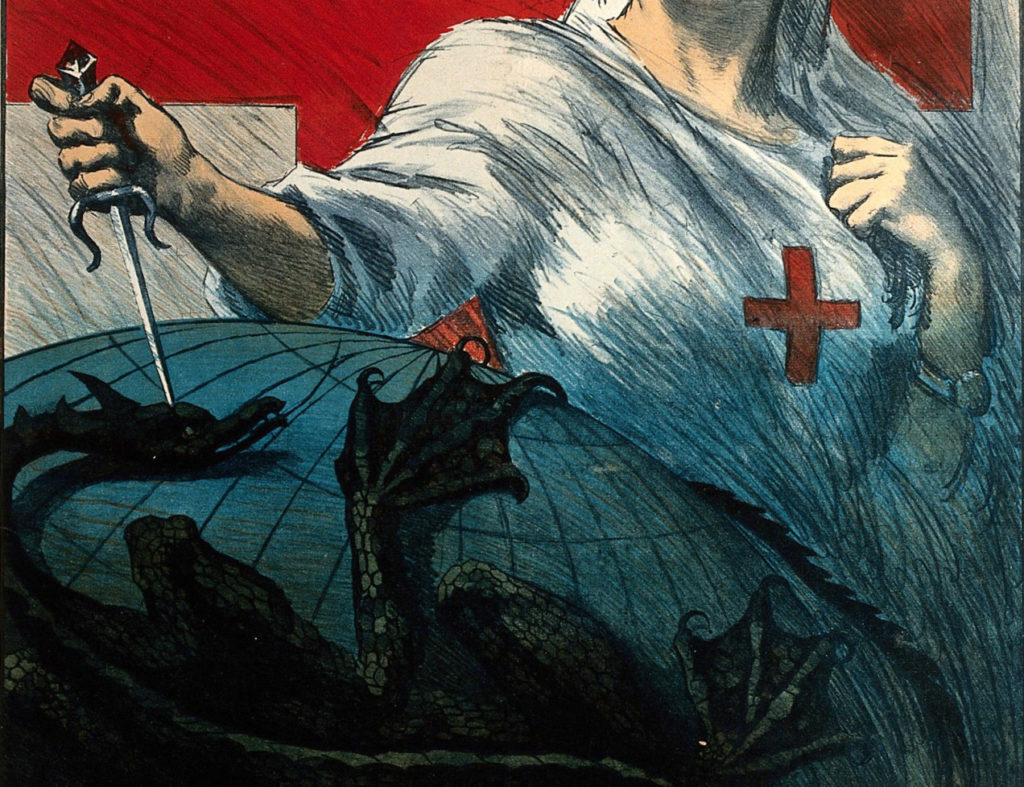
A still from Dis-Ease: a nurse stabbing a dragon encircling a globe
© Wellcome ImagesHer film (which she categorises as a ‘creative documentary’) focuses on how treatment of the sick has been influenced by the metaphors used to describe illness, which often conflate threats from bugs with those perceived from other people. Its chief weapon in that ‘struggle’ turns out to be terminology lifted straight from the battlefield to both: a ‘war on disease’, and on those imagined who carry it. Time and again, she shows how this has resulted in isolating and persecuting certain groups: immigrants quarantined on islands, for example, or neighbourhoods condemned through loose designations as ‘hives of sickness’.
Another of the project’s exhibition outputs, co-produced with the Museum für Naturkunde in Berlin, was cannily entitled Koexistenz. The word suggests a more complicated inter-relationship between humans, non-human animals and microbes, than the binary implications behind the dominant talk of eradication and submission: winning or losing wars. In tackling these immensely complicated (as well as fascinating) issues, multiple perspectives were vital. A key characteristic of the Contagious Cities project was the juxtaposition of contemporary and historical concerns; the blend of insights from a multitude of disciplines and perspectives; the balance of poetic and more didactic responses; and, as a thread weaving all of that together, the application of cultural practice.
Curatorial approach
https://dx.doi.org/10.15180/201405/003Contagious Cities was an initiative staged across four global cities – Berlin, Geneva, Hong Kong and New York. In each place, the core Wellcome team supported interrogations of a vital global health challenge (epidemics and pandemics), which the Contagious Cities’ co-curators, scattered across dozens of institutions, found inextricably embedded in very different and diverse local, and indeed personal, contexts. At the project’s core was an experimental approach to co-producing artist residencies, exhibitions, broadcasts and public-programming, all developed in collaboration with informed individuals and organisations from different perspectives – an evolving community of ‘fellow enquirers’. The initiative also exploited Wellcome’s unique position as an international foundation, simultaneously involved in academic research, health and medical policy, but also, crucially, cultural programming and collecting.
At the end of the project, Wellcome’s production team have been convinced enough of the value of this type of work to embark on a second initiative. Mindscapes – our new project – will focus on mental health, another of Wellcome’s priority areas. It is a topic which many believe represents a rather different global pandemic: less visible and with a slower burn perhaps, but nonetheless burgeoning. Here, too, our efforts will be to use cultural programming and fleet-of-foot enquiry to animate multiple and unexpected connections between institutional interests that can sometimes get pulled apart, even within the same organisation. Following in the footsteps of Contagious Cities, Mindscapes will again aim to make the most of Wellcome’s resources and expertise in: funding new and exciting research; focusing increasingly on strategy and policy around core global health challenges; and continuing an on-going commitment to engage different publics through different means.
Emboldened by our sense of the impact of Contagious Cities, we are nevertheless still keeping an open mind about how best to proceed with our singular curatorial remit, or indeed how most effectively to articulate our goals without simply relying on pre-formed corporate statements. How can exhibitions and events in venues far away from Wellcome’s London headquarters most fruitfully be co-produced? What mutual learning can result from such international partnerships? How can very different interests and work amongst cultural practitioners, researchers and those involved in policy and advocacy be tellingly juxtaposed? And how might innovative, non-instrumentalist content for significant and diverse audiences be best coaxed from such a cocktail? In this article, we use what we have learned from this first experiment to explore these questions and share some provisional conclusions.
Serial partnership and multiple outputs
https://dx.doi.org/10.15180/201405/004Wellcome’s sheer scale as a medical foundation enables it to make a difference in many areas of medicine. A long-standing priority has been studying and tackling infectious diseases, with an increasing focus in recent years on preparing for epidemics. Not surprisingly, Wellcome has been at the centre of much of the national and international response to the crisis that has swept the world since the start of 2020 – financially, academically, and as a convenor (in, for example, the Coalition for Epidemic Preparedness Innovations – CEPI) of medical and health-focused organisations.
Choosing to put disease and contagion at the centre of a new strand of international cultural activity was therefore not unexpected; but how to execute the initiative was far less clear. We drew on extensive experience of exhibition and event-making in Wellcome Collection, and trusted that rich results were likely to emerge from collaborations with interesting people and organisations. Contagious Cities then had rather little of the currently fashionable Theory of Change rationale about it, where desirable, pre-determined goals are attempted through evidence-based activities, mapped across a framework. It was instead founded on a core methodology of multiple partnerships, built up through organic growth, where licenses given to initial investigative elements were iteratively extended, linked and amalgamated. This highly unusual, possibly unique approach to cultural programming in part emerges from the extraordinary breadth as well as depth of Wellcome as an organisation. Its evolution was guided by a more-than-the-sum-of-its-parts presumption, and a belief that investing in rich processes and relationships can result in their own form of less pre-determined impact.
Leading with artistic enquiry
https://dx.doi.org/10.15180/201405/005Within Wellcome Collection we had already undertaken a number of international projects. A key feature of Contagious Cities was drawn from one in particular – Art in Global Health – which, in 2012, commissioned six artist residencies in medical research centres across the world.[1]
The artists involved were:
- Miriam Syowia Kyambi (whose art frequently interrogates aspects of perception and memory) and James Muriuki (who primarily works with photography, video and sound) in Kenya;
- Elson Kambalu in Malawi (a self-taught artist based in Lilongwe, whose output ranges from paintings to sculpture and installations);
- Zwelethu Mthethwa (a Cape Town-based artist, who often produces large-format colour photographs) and the Mtubatuba Workshop in South Africa;
- B-Floor Theatre (Thailand’s vanguard physical theatre company, often focusing on sensory storytelling);
- Katie Paterson, based in the UK and Germany (who frequently conceives of nonconceptual projects that use sophisticated technologies and specialist expertise);
- Lêna Bùi in Vietnam (an artist based in Ho Chi Minh City, interested in, among other things, how subtle everyday rituals can reflect beliefs).
The projects led by their varied art-practices allowed wonderfully collaborative investigations based on local forms of knowledge production, both scientific and cultural, that cut across broad topics and institutional agendas.
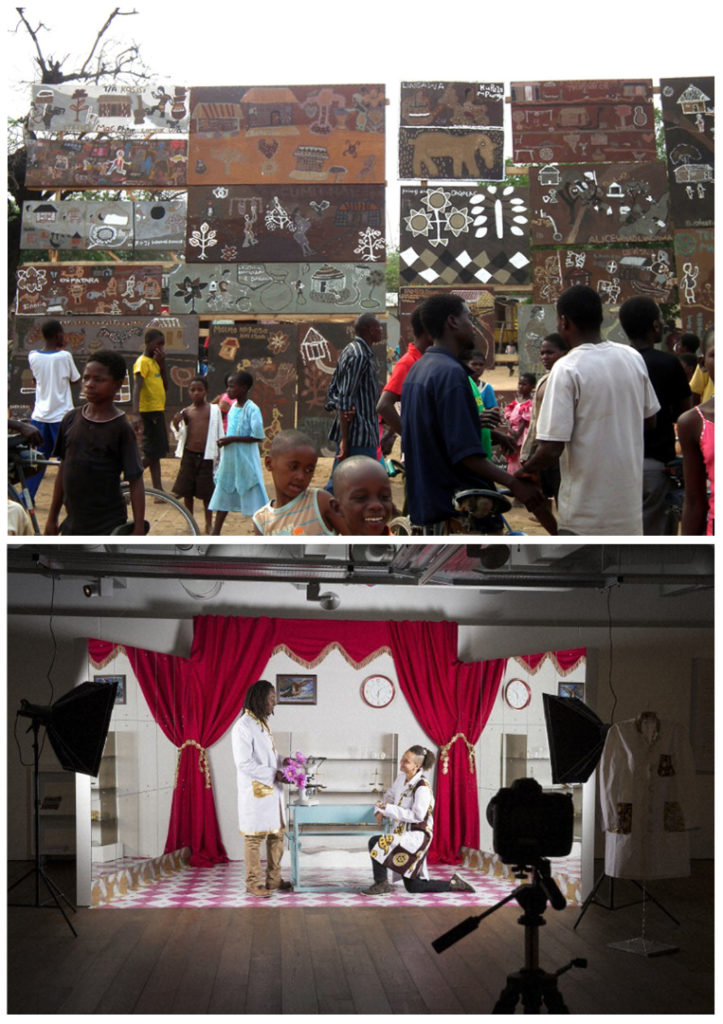
(Top): Display of soil-based paintings inspired by Chikwawa community women’s experiences of seeking health, Kafukufuku Arts Festival (2012)
(Bottom): Pata Picha Studio, Syowia Kyambi and James Muriuki, Foreign Bodies, Common Ground exhibition
© Elson Kambalu / Wellcome TrustLêna, for example, worked with a research group investigating zoonotic diseases in rural Vietnam, exploring ethical dimensions of how humans interact with animals, making a film based on her exploration of a highly specialised farming practice harvesting bird feathers. While in Kilifi in Kenya, Miriam and James collaborated with the Wellcome funded Kenya Medical Research Institute, using a portrait-based project (Pata Picha Studio) to highlight ways in which health researchers and their involved subject communities depend on and perceive one another.
What became clear throughout these residencies, and collectively manifest in the subsequent group show Foreign Bodies, Common Ground at Wellcome Collection, was the potential for artistic investigations not only to open up and deepen research, enabling meaningful encounters between different ways of seeing and understanding, but also the potential for varied methodologies and connections to inform considerations of venue, audience, exhibition/event format, as well as approaches to interpretation, relevance and collective enquiry.
Our experiences of that earlier project were extensively drawn on in Contagious Cities’ approach to co-production, though applied rather differently in the project’s key cities: Geneva, New York, Hong Kong and Berlin. Along with the rich histories and significant contemporary approaches to epidemics found in each of these global metropolises, the project’s geography was also influenced by a range of existing links Wellcome had already established through research and policy work, as well as through its investments. In each city, we again placed special emphasis on how the work of commissioned artists could help shape our collaborative exhibition making and public programming. Contagious Cities ended up showcasing the work of many others, but four commissions played an especially leading role: Blast Theory in Geneva; Mariam Ghani in New York; Angela Su in Hong Kong; and Simon Faithful in Berlin.
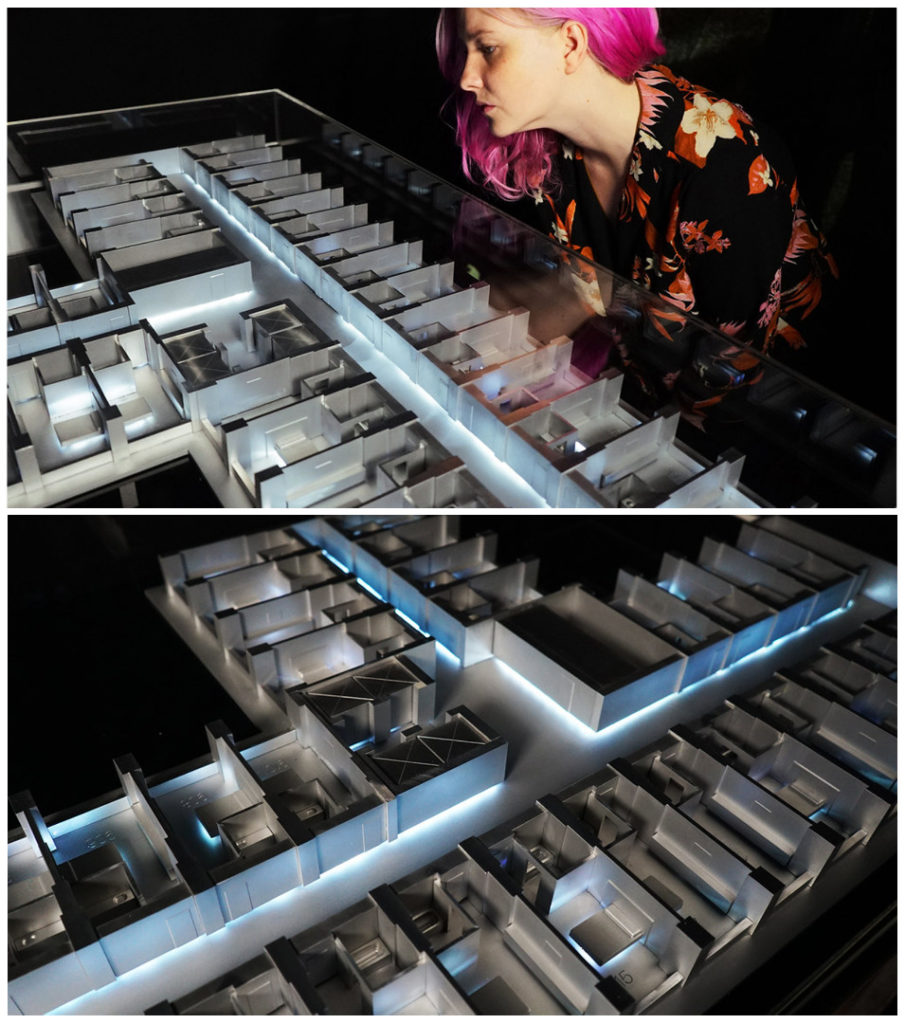
‘A Cluster of 17 Cases’ by Blast Theory, which was shown in the New York and Hong Kong exhibitions
© Blast TheoryEarly in 2018, exactly a hundred years after half of Geneva’s citizens had been widely infected by the flu, Blast Theory became the first ever artists-in-residence at the World Health Organization (WHO) – based in Geneva. They conducted interviews and observed meetings in WHO’s Strategic Health Operations Centre, where epidemics around the world are monitored daily, and responses planned. From their research they created ‘A Cluster of 17 Cases’, a mixed-media work focused on the 2003 outbreak of Severe Acute Respiratory Syndrome (SARS), which began on the ninth floor of the Metropole Hotel in Hong Kong on the night of 21 February. In New York, Mariam Ghani based herself at the Graduate Center of the City University of New York (CUNY), and made her film Dis-Ease by drawing on a wide range of film and documentary footage she collected, particularly in the New York Public Library (NYPL) and Wellcome’s library. Inspired by traditional Chinese medicine, cosmology and philosophy, Angela Su’s rather different research took place in Hong Kong and London, where she interrogated the complexities and contradictions surrounding a city labelled ‘contagious’.
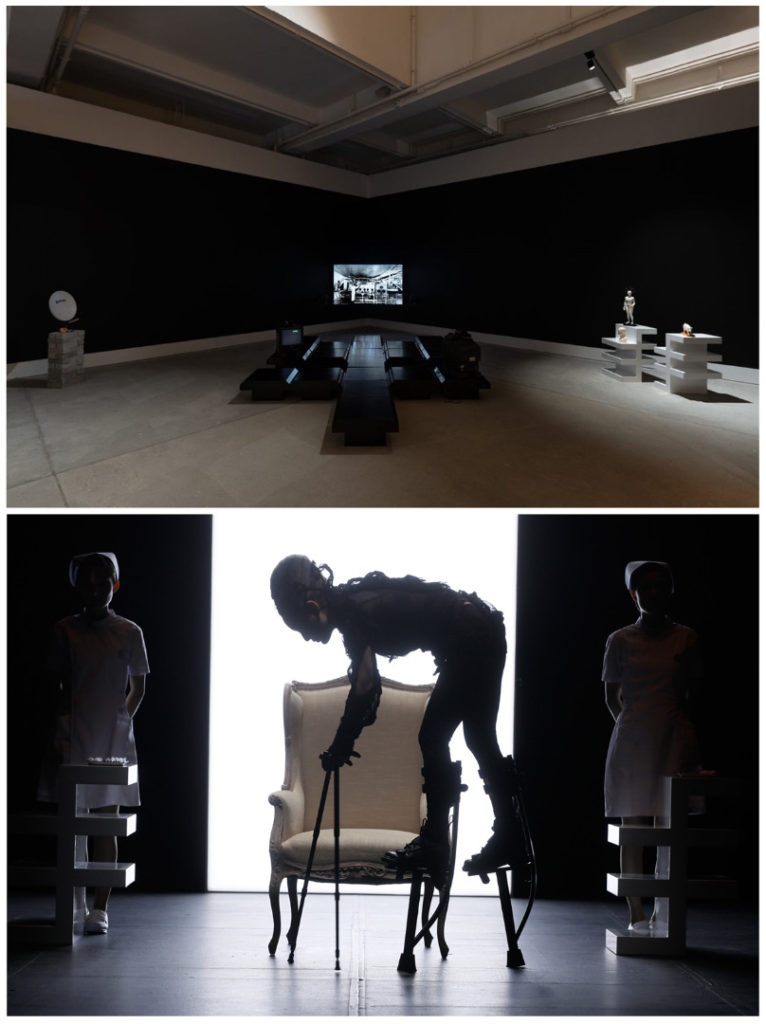
(Top) Hong Kong artist-in-residence Angela Su’s installation in the Far Away, Too Close exhibition
(Bottom): Angela Su’s Far Away, Too Close performance still
© Tai Kwun / Cheung Chi WaiSimon Faithfull lives and works in Berlin, and his residency took place in the Museum für Naturkunde, specifically in its collection of birds. His gallery installation, ‘An Arbitrary Taxonomy of Birds’, presented his own drawings alongside some eighty bird specimens, including one – the chicken – thoroughly implicated in spawning zoonotic diseases.
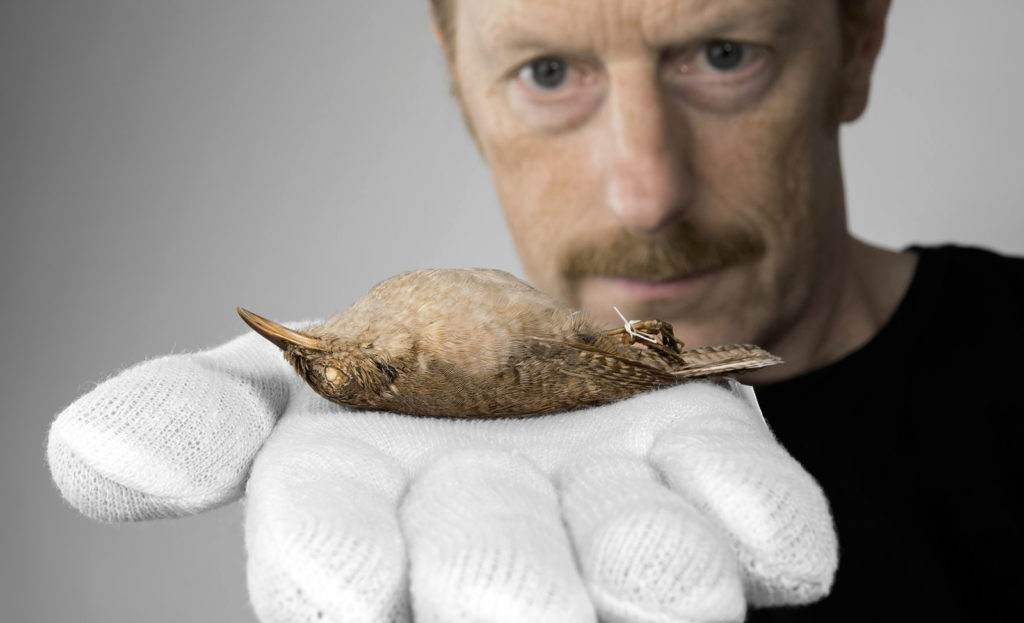
Berlin artist-in-residence Simon Faithfull with a specimen from the Museum für Naturkunde
© Hwa Ja GötzOur conviction about the value of working with artists in projects otherwise defined by themes in science, medicine and health is based on more than two decades of experimental practice. What has become increasingly clear to us over that time is the breadth and flexibility of their commissioned work, as well as its ability to surprise. In some instances, they have helped narrate, visualise, aestheticise and disseminate ideas from other disciplines. Somewhat more disruptively, their instincts can instead raise more critical voices, shining a probing, sometimes uncomfortable light, often challenging assumptions. Increasingly, we have found collaborating with artists helps us find and give voice to perspectives that can frequently be left out, or sometimes deliberately silenced. Artworks can also help us dwell on individual, first-person perspectives, highlighted against a more general ‘objective’ view on offer from other disciplines. And on many occasions, this has reminded us that scientific and medical topics and ideas can and should be felt as well as thought about. Though it is a mistake to imagine that art cannot also be about understanding, or indeed that science isn’t sometimes closely tied up with deep feelings. Artworks and projects can also flesh out broad social and cultural contexts in which to contemplate topics in health. While more and more these days, they are also expected to enlighten and prompt behavioural change or action; or alternatively to alleviate stress and strain, helping audiences with their wellbeing. The menu of roles for art is long. And artists could be forgiven for feeling some trepidation, if not exhaustion, faced with all these expectations. Luckily, artists also have a healthy habit of defying expectations, of finding unexpected purposes, or precisely the lack of them, in their own processes. These surprises probably provide us with the most compelling reason to put collaborating with artists at the core of much of our work. (On the role of art in the context of science see, Arnold et al, 2020.)
Public outputs
https://dx.doi.org/10.15180/201405/006Along with three substantial artist commissions (the results of which were each embedded in at least one of the major exhibitions in New York, Hong Kong and Berlin), we also engaged with academic researchers from different disciplines and curators, brought together in a few key institutions, including museums and universities. These widespread collaborations resulted in a set of co-produced exhibitions, interactive storytelling experiences and live events/displays. Another strand of the project involved collaborations with broadcasters, some more international. The outputs in Geneva ended up being more stakeholder than public facing, but the artwork developed by Blast Theory at the WHO headquarters was shown in both New York and Hong Kong.
Exhibitions
https://dx.doi.org/10.15180/201405/007- Germ City: Microbes and the Metropolis at the Museum of the City of New York took a fascinating look at the city’s long battle against infectious diseases – a fight involving government, urban planners, medical professionals, businesses and activists. It was developed with the New York Academy of Medicine, and featured a version of Mariam Ghani’s Dis-Ease film as well as Blast Theory’s piece.
Mariam Ghani, New York artist-in-residence installation view in the Germ City exhibition at the Museum of the City of New York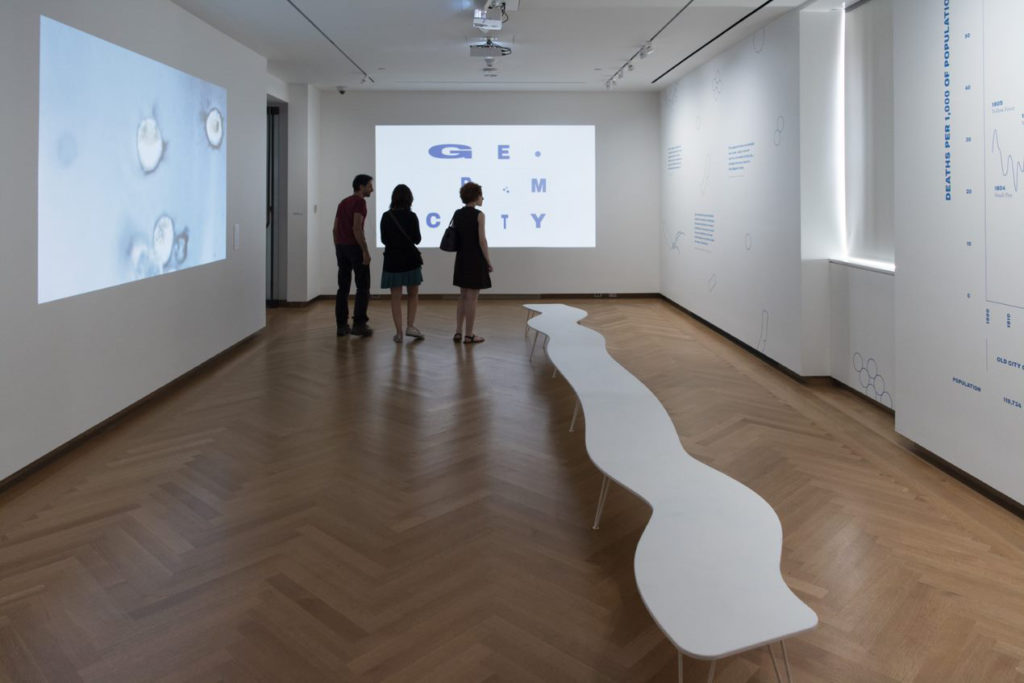
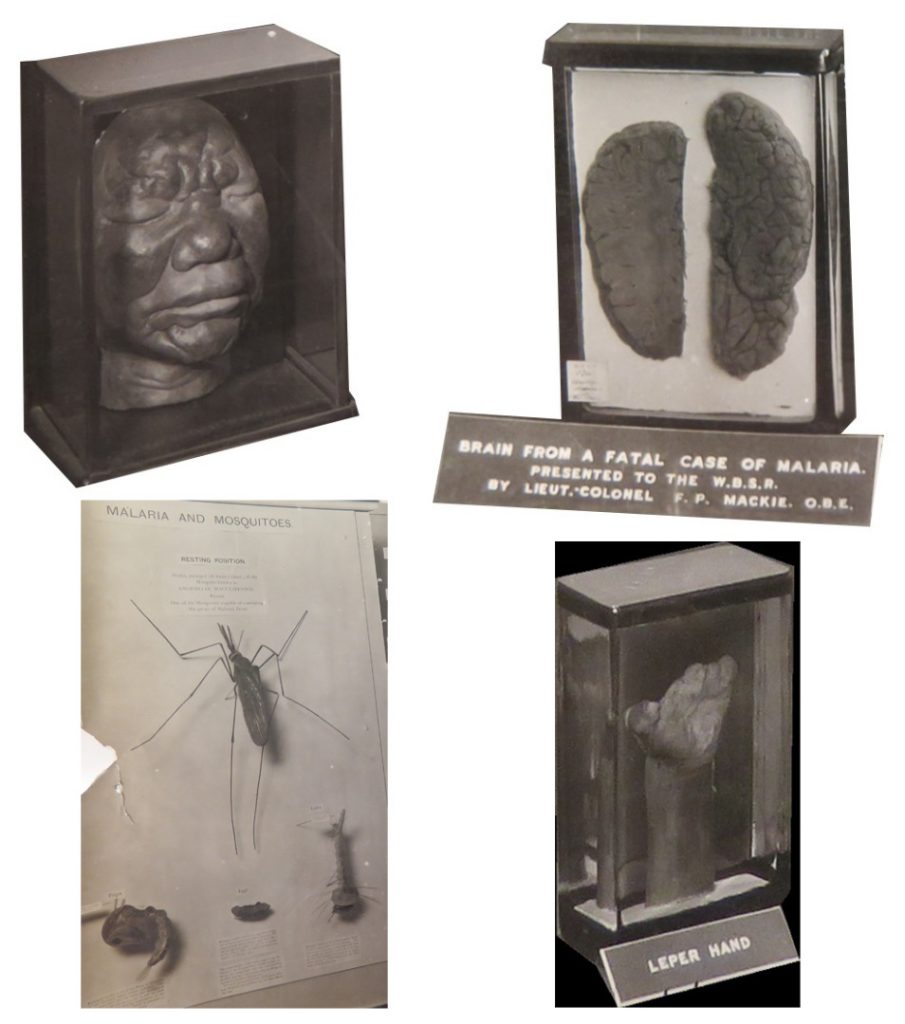
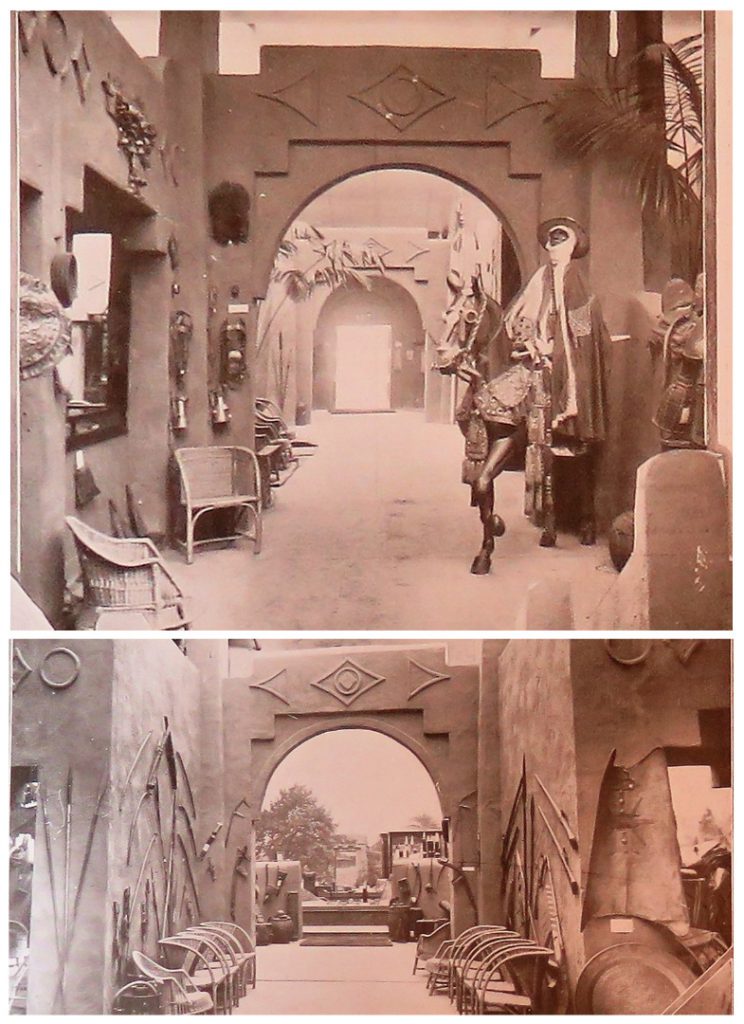
- Contagious Cities: Far Away, Too Close at Hong Kong’s Tai Kwun Centre for Heritage and Arts was co-produced between their art and heritage teams. It featured Angela Su’s pieces amongst many other artworks (including Blast Theory’s piece), and explored the psychological and emotional dimensions of disease and contagion, particularly in relation to people’s ordinary lives.
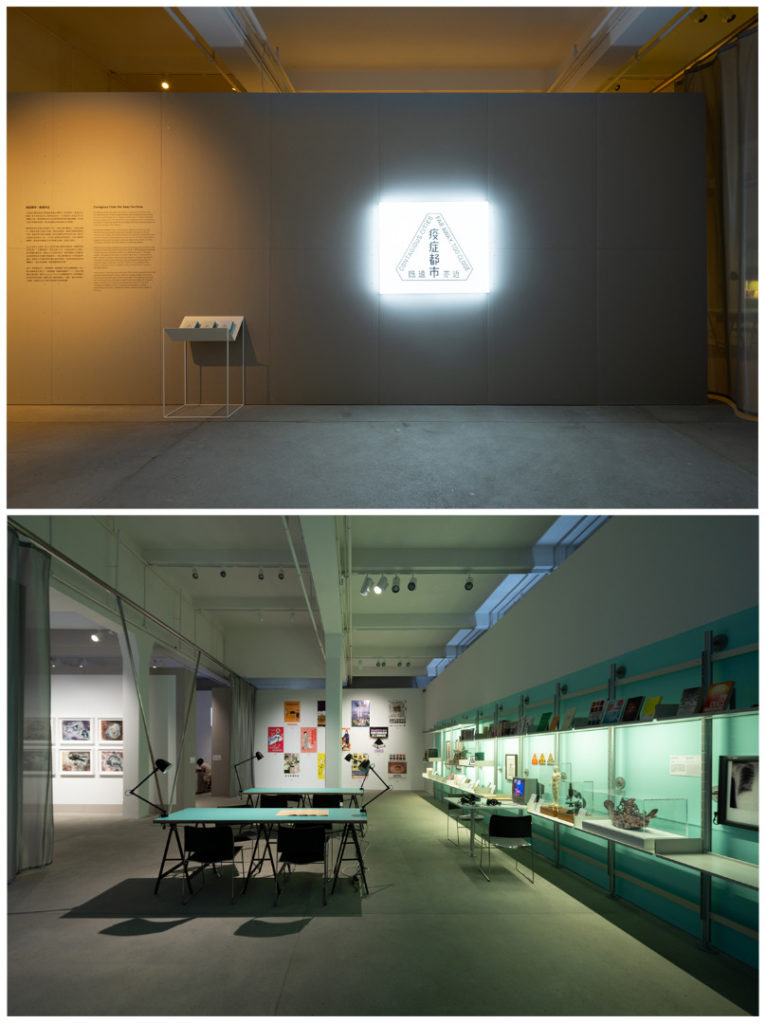
Exhibition views from Far Away, Too Close exhibition in Hong Kong at Tai Kwun Centre for Arts and Heritage
© Kwan Sheung Chi- Koexistenz at the Museum für Naturkunde involved collaborations between artists and scientists that explored the relationship between humans, animals and viruses. It included the artistic commissions by Simon Faithfull and Sybille Neumeyer. The exhibition was complemented by public talks and events in the Museum’s Experimental Field.
Interactive storytelling experiences
https://dx.doi.org/10.15180/201405/008- A series of special tours of the Tenement Museum’s historic tenement buildings located on Manhattan’s Lower East Side, which told stories linking themes of disease, medicine, immigration and reform in the lives of their former residents.
- Taipingshan’s history of plague centred on Hong Kong Museum of Medical Sciences presented through a heritage trail, and a guided app.
- A narrative cartography of viruses created as a guided walk by artist Sybille Neumeyer, tracing stories of influenza, pandemics and viruses in and around Berlin’s Museum für Naturkunde.
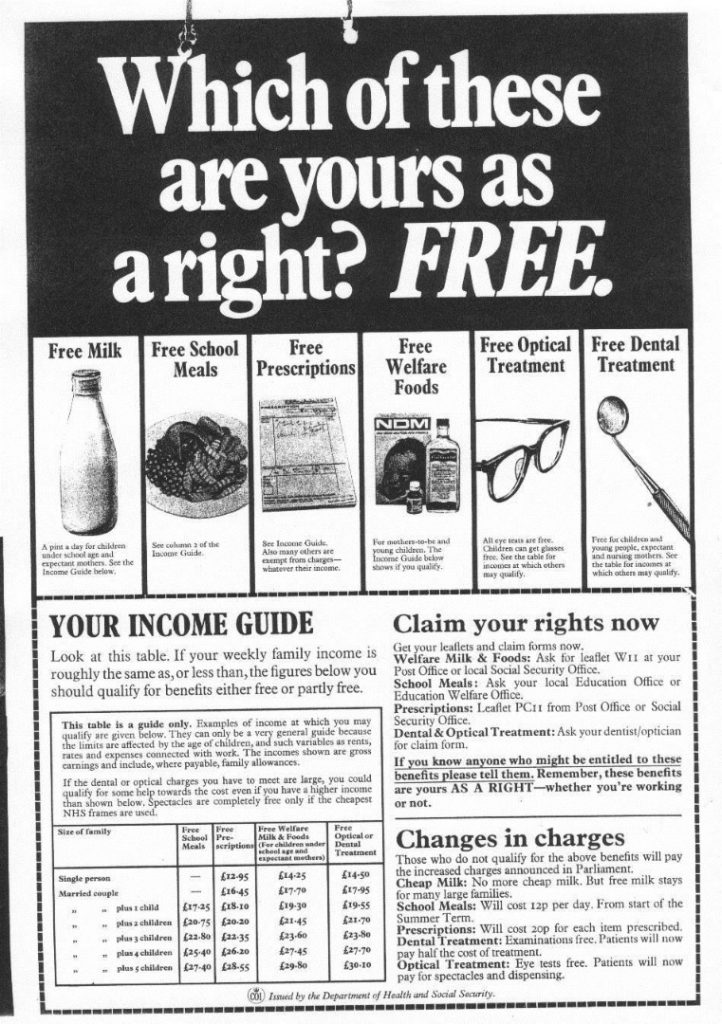
Broadcasts
https://dx.doi.org/10.15180/201405/009- A series of commissioned essays (in partnership with BBC Radio 3 and Cast Iron Radio), in which five writers considered the history and effects of a different contagion in their city. [2]
- A series of narratives chronicling the relationship between New York and various contagious diseases, produced by WNYC (operated by New York Public Radio).
- Several episodes of Brooklyn Historical Society’s award-winning podcast Flatbush + Main focusing on the history of disease and public health in Brooklyn.
- A special SARS-focused episode of The Evidence, produced in collaboration with BBC World Service and Wellcome Collection, recorded at the Tai Kwun Centre for Heritage and Arts.
Events
https://dx.doi.org/10.15180/201405/010- Oi! Street Visual Art Space presented Contagious Reading, an instillation and events produced by writer Lawrence Pun and artist Tozer Pak, focused on the importance of sharing knowledge through writing and art.
- Art in Hospital (Hong Kong) produced a project entitled Our Times, a series of art workshops, exhibitions and activities exploring people’s memories and experiences of disease.
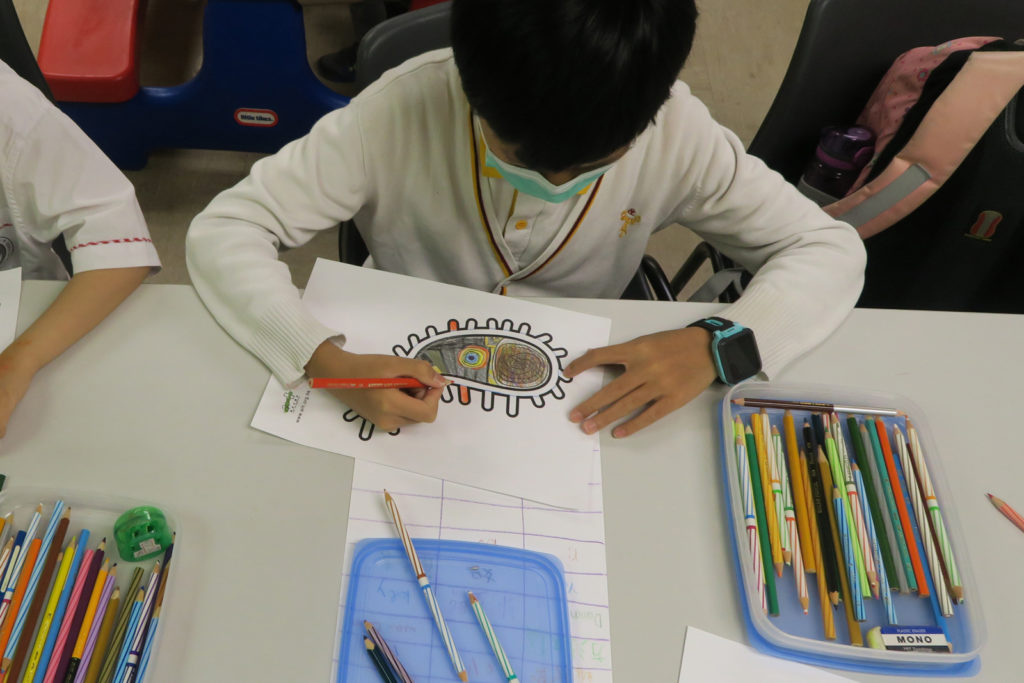
Art in Hospital workshop participant
© Art in Hospital- Asia Art Archive (Hong Kong) convened a series of talks and workshops focusing on zines as a self-published medium themed around diseases and epidemics.
- Common Core (The University of Hong Kong) held a variety of events and activities, including Jazz Thoughts and Ferris Wheel Lectures around the concept of contagion.
- The New York Public Library showcased a display exploring more than one hundred years of mapping contagion in the city, and in collaboration with the Graduate Center of City University of New York produced a series of public events looking at how stories of contagion are told.
- The New York Academy of Medicine, in collaboration with the Museum of the City of New York, offered a diverse range of panel discussions and events, as well as walking tours of Roosevelt Island and the Ellis Island Hospital Zone.
Outcomes and impact
https://dx.doi.org/10.15180/201405/011As an international cultural experiment, Contagious Cities was less primarily concerned with the scale of its impact, or certainly not in the conventional sense of measurable engagement, than say a more conventional touring exhibition. We were, of course, extremely interested in how broadly and how well the project elements were received; and were eager for as big an international audience as possible to have the richest possible variety of cultural experiences through it. To investigate its impact, we commissioned some ‘learning partners’ (James Doeser and Lizzy Moriarty) early in the process. But as an experimental initiative, we were just as interested in establishing a proof of concept for this way of working, and indeed in understanding how this deliberately organic project evolved. A second, more difficult remit for our learning partners then was to help us in understanding the relationships established through this way of working and how the project evolved through them, and to help us articulate the value of this approach to cultural programming.
In terms of summative evaluation, we wanted at least to aggregate what our multiple partners found out about their audiences, and as the project concluded we were delighted to discover that direct visitors in excess of half a million had enthusiastically engaged in the exhibitions, walks, workshops and other events we had co-produced. Our radio broadcasts reached many times that number of additional listeners. A flattering consequence of working with BBC World Service is the chance to count audiences in tens of millions. In sum, according to Doeser and Moriarty’s measured conclusion, we know that through Contagious Cities ‘more people are more aware of contagious disease as an issue, … [and] more people think about contagious disease with a new perspective’ (Doeser, 2020, 2–3).
This latter nuanced point – about being just as concerned to shift peoples’ perspectives as to bring the broad subject matter to the attention of audiences at scale – was born out in the more qualitative aspects of Doeser and Moriarty’s evaluation. And it is worth spelling out in a little more detail. This concern with opinions and feelings, in addition to knowledge about health and medicine, builds on the long-standing interest Wellcome has had in surfacing multiple points of view through its cultural activities. From its opening in June 2007, Wellcome Collection was determined to engage its publics through bold combinations of medicine and art, old and new, professional and personal; but also with content that balanced objective ideas and information with more emotional narratives and reflections (though not necessarily distinguishing which was which). Particularly effective in this regard were strategies adopted in Contagious Cities, where personal experiences were blended with factual information, and where particular attention was given to authentic, tangible stories, always contextualised by factual and statistical information.
So in the Germ City exhibition, for example, one of the highlighted diseases was typhoid, which killed many New Yorkers in a series of outbreaks throughout the nineteenth and early twentieth centuries. Along with general information about the disease and its effects, particular focus in the show was given to the Riverside Hospital for quarantinable diseases, located on North Brother Island in the middle of the East River. It was here that Mary Mallon, often referred to as ‘Typhoid Mary’, was forcibly quarantined after being accused of spreading the disease through her itinerant work as cook and laundress: a suspected super-spreader, as we might now have it. Though she always denied being a carrier, she spent much of her later life at the hospital, dying there in 1938. Compellingly authentic exhibits lifted this particular story, highlighting how the disease and contemporary understandings of it among professionals and the public had affected her life and those around her.
A different way of focusing on the power of the particular lies at the heart of Taipingshan Heritage Trail, an audio-visual app which was developed as part of Contagious Cities. In this case, it was the residual tangible evidence of past epidemics identifiable in the contemporary urban geography of this particular part of Hong Kong that provided trigger points for a potent mix of historical understanding and empathy. (The Taipingshan hillside was designated a Chinese quarter shortly after the British arrived in the 1840s. Poor and unhygienic housing led, in 1894, to the outbreak of bubonic plague.) The now tranquil recreational space Blake Garden marks one of Hong Kong’s earliest attempts at urban renewal, following the sometimes brutal official measures to control the disease; the Hong Kong Museum of Medical Sciences, housed today close to Blake Garden in the Old Pathological Institute buildings on Caine Lane, was originally constructed as Hong Kong’s first purpose-built public health and medical laboratory, as well as a vaccine-production site. The guided walk uses story-telling and visual imagery to encourage visitors to apply their mind’s eye and re-imagine these buildings and street corners in a time when the area was infested with plague.

The Hong Kong Museum of Medical Sciences building, the former pathological institute and the plaque at the entrance of Blake Garden, a memorial of the repeated outbreaks of plague in Taipingshan district starting in 1894 and lasting for almost thirty years
© HKMMSA basic idea repeatedly explored through Contagious Cities was how epidemics are characterised by patterns of cultural and emotional connection as well as bodily and microbial infection. Again, forefronting individuals with real names allowed somewhat abstract notions to be made dramatically palpable. One of the bewildering fifty million people estimated to have died from the 1918 flu pandemic was a Romanian Jewish immigrant Jacob Burinescu, who lived with his wife Sarah and their five children on Orchard Street in New York. He ran a cleaning business in the Lower East Side and was active in the local Yiddish theatre scene. He became sick while caring for acting friends who had contracted influenza; an act of kindness that tragically cut short his life. His story was compelling portrayed through documentary evidence found by public historians and brought alive through the special walking tour ‘Life and Death at the Tenement’, which the Tenement Museum developed as a part of Contagious Cities. Details of lives (and deaths) like this are what brought the otherwise incomprehensible statistics of the 1918 flu pandemic into vivid focus. (On the role of museums to make people feel and make meanings for themselves as well as learn, see Message, 2015.)

Romanian Jewish immigrant and former 97 Orchard Street resident Jacob Burinescu, pictured with his amateur Yiddish theatre acting troupe, c. 1900. Jacob is seated on the right. In 1918, Jacob died during the global influenza pandemic, leaving behind a wife and six children
© Collection of the Lower East Side Tenement MuseumDiseases like flu a hundred years ago, and COVID-19 now, spread rapidly around the world; as too – thankfully – does the application of science in understanding and mitigating how they do so. The parallel transport of bugs, ideas and knowledge provide intriguing reminders of just how small the world has become. But the collaborative work of geographically-rooted researchers, artists, health-workers, urban-planners, writers and film-makers given centre stage in Contagious Cities simultaneously reminds us just how different and locally distinctive diseases and people’s suffering – as well as abilities to deal with them – can be. In this way, Contagious Cities highlighted how fast the world is shrinking, but also how stubbornly and inspiringly big it still is – even though the diversity that it uncovered lay in the darkness of disease.
Co-production
https://dx.doi.org/10.15180/201405/012What brought together this richly textured content were the contributions of organisations and individuals across cities, cultures, histories and languages, albeit with English as the default lingua franca. Unambiguously a Wellcome project, the significance, authenticity and cumulative impact of Contagious Cities emerged from that network of partnerships, animated, we hoped, by a spirit of mutual learning.
Not always easy to identify, let alone talk about, it is nevertheless important to acknowledge that issues of power were, inevitably, embedded in the initiative. It was certainly not produced at the instigation of our local partners: Wellcome made the initial approaches, controlled much of the direct budget, and set both the topical focus and the overall approach. It would have been frankly naïve to ignore the potential neo-colonial framing of our efforts to co-programme around subject matters well beyond our own expertise, and in venues far from Wellcome’s London headquarters. These dynamics surfaced, for example, in the seemingly trivial issue of titles. Individual exhibitions and events adopted names chosen locally, and the use of subtitles and tag lines was also largely done case by case. However, we did expect the pre-determined name of the whole project (Contagious Cities) to appear in some shape or form throughout.
Pursuing any kind of international project on behalf of an organisation as large, wealthy and influential as Wellcome entails intrinsic risks around relationships. We wanted to be mindful but not paralysed by them. Eager to exercise humility and exert influence judiciously (especially around budgets), we also challenged ourselves about how much control we could relinquish. Interestingly, some of our collaborators revealed at the end of the project that they might sometimes have appreciated firmer guidance. Power can, of course, be exerted in many different ways; and our greatest source of influence often turned out to lie in our ability to connect people, exercising the ability to make introductions and facilitate conversations. Our curatorial skills were thus often more effectively applied in building and forging relationships than in the more traditional forms of presentation or content.
Not infrequently, Wellcome’s involvement was reflected in the institutional boldness shown by our partners: the formation of new collaborations and adoption of unusual ways of working within institutions, or maybe with less familiar types of content. In New York, for example, we were happy to encourage the Museum of the City of New York to collaborate with their neighbours The New York Academy of Medicine in curating the Germ City exhibition, and to facilitate the integration of more contemporary art than was perhaps typical of MCNY’s already impressive and imaginative historical exhibitions. In Hong Kong, we were drawn to work with both the heritage and contemporary art sections of Tai Kwun and were delighted that their Contagious Cities: Far Away, Too Close show bridged the two. While in Berlin, our major partner was the Museum für Naturkunde, to which we introduced artist Simon Faithfull, who explored their ornithology collection through his own quixotic and poetic taxonomic instincts. Drawing on and sharing the great expertise of Wellcome’s staff and the extraordinary resources of its research networks, our curatorial role ranged across making introductions, suggesting unexpected links, encouraging playful approaches, freeing up space and time for partners, and generally exerting our power through a license to disrupt and surprise.
We were especially keen to point to Wellcome Collection’s reading room as a potential curatorial model for mixing varied materials and types of engagement in a harmonious miscellany.
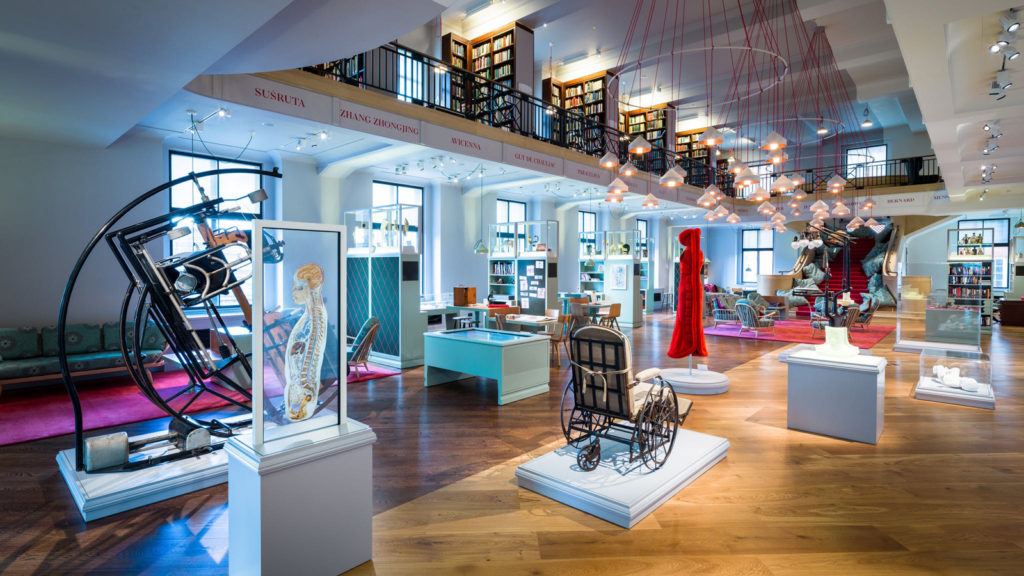
The Reading Room, Benjamin Gilbert
© Wellcome ImagesIts stunning but relaxing spaces offer an unusual hybrid of library and museum, where thematic groupings of books, exhibits, activities, small-scale events and plenty of comfortable furniture facilitate both active and passive engagement for visitors of many different ages and interests. The curatorial approach to this room gave us something tangible to point to as we encouraged our partners to experiment when creating their own platforms for public enquiry. How might they use exhibition-making in their own unique institutions as a means to shift power dynamics in inspiringly different contexts we wondered? The results were fascinating. In Hong Kong at the Far Away, Too Close exhibition, for example, this led to a series of ‘playback theatre’ events, where recollections of SARS shared by exhibition visitors were turned into small scale dramatic events; while in New York, one of the two exhibition rooms in Germ City took on a hybrid form of gallery and library where visitors viewed historical artifacts and Blast Theory’s artwork, but also delved into the exhibition’s themes through selected books and digital interactives, sharing comments and reflections with later visitors.
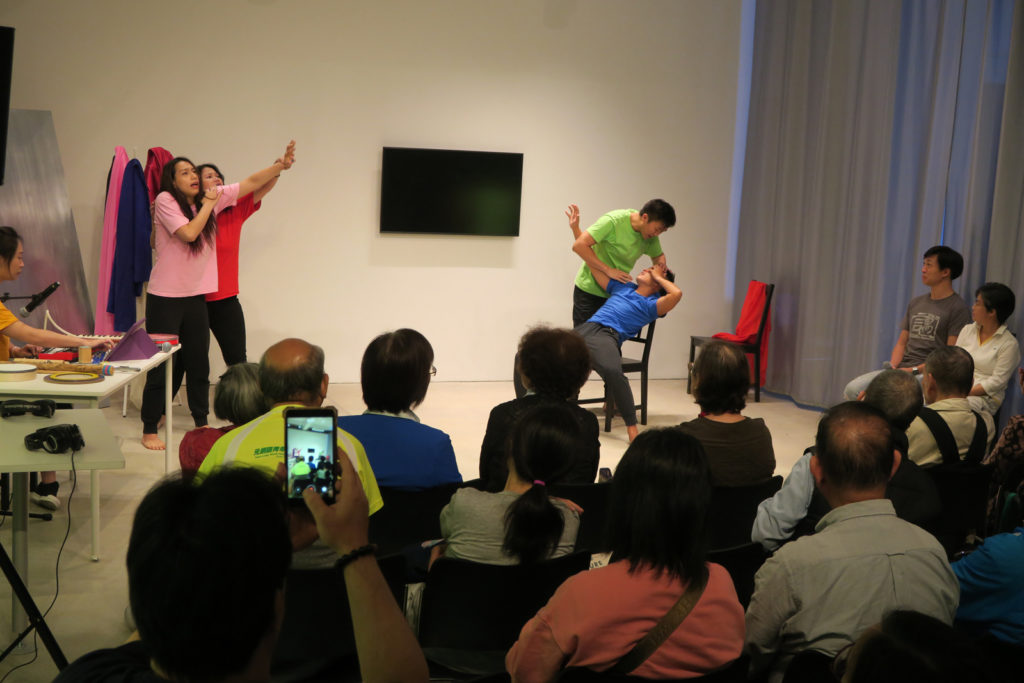
Playback theatre at Far Away, Too Close Tai Kwun exhibition in Hong Kong
© Kwan Sheung ChiWorking in this open way gave us opportunities to learn much from a wide range of inspiring partners; lessons we aim to apply in our next project. So, for example, it became clear that a better articulation of our particular approach to co-production could help us, especially in the early stages of forming partnerships.[3] We also became aware of how valuable it would be to engage project facilitators in each city, in order to help make and maintain connections, as well as ease the flow of ideas and resources between local participants. We also envisage these coordinators improving one further weakness of Contagious Cities by helping us foster international exchange earlier in the project. Rich potential for comparative learning was very much in evidence during the project’s summative workshop and could have been activated well before then. Our new love affair with video-based meetings, blossoming under lockdown conditions, will also encourage earlier steps in that direction.
Culture and Cause
https://dx.doi.org/10.15180/201405/013Another highly experimental aspect of Contagious Cities lay in the links it attempted to forge between cultural programming and health advocacy. Could each, we wondered, somehow add to the other? Might the vitality of an important health issue like epidemic preparedness help spike the relevance of exhibition and event-making around this topic? And could the contemplative breadth of cultural enquiry genuinely add different dimensions to strategic conversations with international stakeholders?
Wellcome’s spread of activity, as well as its distinctive origins and history, puts it in the unusual position of being able to test out these hypotheses. In recent years, it has undertaken increasingly vigorous work around global health policy and advocacy, for example playing significant roles in debates about the overuse of antibiotics and the diversity and inclusivity of the culture within which science is conducted. Not surprisingly, the COVID-19 crisis has put issues of epidemic preparedness at the front and centre of this work. Wellcome’s cultural activities on the other hand emerge from the interests and activities of its founder Henry Wellcome. His broad concerns with medicine (including much of what we might now term wellbeing) extended across the entire world; and his acquisitive interest in what he found led to the formation of an extraordinary collection of art and artefacts. (A significant part of that enormous collection has recently been redisplayed in the Science Museum’s new Medicine galleries, described further in this issue.) Wellcome Collection (the current day museum and library) showcases many of those exhibits, and in its establishment in 2007 drew inspiration from his omnivorous curiosity, even though much of his thinking was, inevitability, informed by opinions thoroughly of his time. The way in which Contagious Cities braided Wellcome’s interests in culture with a vital public health cause is in some ways just another more introspective version of co-production, this time played out within our organisation’s own departmental structure.
Ed Whiting, Wellcome’s Director of Strategy, describes our thinking this way: ‘It’s our version of “cultural diplomacy”, traditionally understood as the way that Governments have used cultural events and artefacts to promote their national identities and interests… At Wellcome we don’t have a particular agenda to promote in a way that a national Government would, but for me there are some similarities about the way that we think this sort of activity could help us achieve our mission of improving health around the world. Our theory is that cultural engagement like Contagious Cities can link together the individual and global community in a shared experience that both bring a current or historical health challenge (in this case, epidemics) to life and challenge the way the viewer might think about these issues and health more generally.’ More comfortable with terms such as ‘cultural relations’ and ‘cultural engagement’ than the often overtly nationalistic ‘cultural diplomacy’ and ‘soft power’, these aspirations for additional impact from our work nonetheless draw on centuries-old traditions of grafting cultural events to the craft of institutional persuasion. (See Ed Whiting blog-post.)
Our approach is, of course, framed by fast-shifting opinions about the value of – many would say the urgent need for – culture being mobilised towards societal and political ends. Focusing specifically on museums, ICOM’s proposed new definition captures the impetus of this thinking: museums, it is on the brink of suggesting, should now be understood as ‘democratizing, inclusive and polyphonic spaces for critical dialogue about the pasts and the futures’. At Wellcome, issues about the aims behind and methods employed to execute our international cultural initiatives are about to be tested again in Mindscapes, our new initiative. Though an organisation unusual in many ways, as well as unusually powerful, the questions we are juggling with as we embark on this new cultural initiative are ones familiar to many other museums and galleries active today. Engaging in the vigorous debates around them with colleagues in other institutions will be a key guide to how we execute this initiative. Are we, we wonder, best to focus simply on raising questions about its core topic – mental wellbeing – or should we go further and provide visitors and audiences with ideas and evidence about what seems to work for those with lived experiences of mental illness? Should we go further still and try to nudge audiences into healthier behaviours (cultivating sensible digital diets, for example, or exercising regularly), or maybe instead restrict ourselves to engaging and hoping to influence policy makers so as to change the understanding of what can make a difference and maybe the landscape of care? We anticipate that different parts of the project will try out different variations along this continuum of approaches and motivations.
We are eager ourselves to draw lessons from Contagious Cities in our new project. And through this article, we are also hopeful that some of what we’ve learned from that experiment might prove informative to others working on projects that mix cultural with social ambitions. One rather pragmatic insight we gained, arguably too far into the project, was the need to juggle different timescales that are involved in effective curating and advocating. In much broader, more complicated geographical terms, we will contribute to a collective exploration of new types of cultural internationalism, testing out approaches that we think make sense for an organisation like Wellcome in today’s global world. Our cultural projects can only be meaningful, we believe, if operated in three or four key locations at one time – Bengaluru, Berlin, New York and Tokyo have been chosen for our new mental health project. Factors that have to be balanced in choosing these geographical locations include organisational, topical and cultural ones, as well as broad-scale geopolitical and global-ethical issues around how to stretch East as well as West, South as well as North. At this scale, it is still potentially possible for all partners to find each other and identify those with whom contact and communication might be most fruitful. It is also worth remembering that a concern for internationalism can just as meaningfully be played out between groups with different geographical and ethnic backgrounds within these ‘global’ cities as between them. Over the coming three or four years, our ambition is to help Wellcome further activate, challenge and support an international network of cultural engagement.
We are convinced that the healthiest exchange between cultural practice and aspects of activism, advocacy and policy that are implicated by a project’s topic has to be two-way; but questions of how to manage that traffic still abound. For Wellcome these subject matters are inevitably linked to medicine and health; for many other cultural institutions the politics of identity and equity currently predominate. But issues of the role that arts and culture can play in such big issues are shared. Our work on Contagious Cities has reinforced a wariness we have of approaching artists and cultural producers with heavily prescribed outputs, or tightly defined themes, already in mind. Our continued preference will be for open-ended approaches that surface unexpected ideas through the creation of artworks. And our experience suggests that artists often end up drawing most powerfully from where their own instincts and experiences lead them, rather than those pre-selected for them. This is rather different from more instrumental, message-led methods that can be so effectively employed in communication campaigns. Though at a project-scale, these distinctions are often less easy to maintain, and maybe more interesting to blur.
Within Wellcome as an organisation, Contagious Cities was, in part, comprehended and supported as an unusual means by which to engage stakeholders. Looked at from this angle, our involvement in culture gives Wellcome the convening power to bring together voices that can sometimes be left out of the conversation – those with lived experiences of illness and health challenges, for example. Here then, culture provides a ‘compelling space’ (often literally in the form of delightfully real places), where a wide variety of relevant perspectives can be curatorially gathered on a relatively equal footing. In this way, we can intercut the confidence of an organisation that supports great depth and breadth of expert thinking (straddling the sciences, humanities and arts) with a humbleness to pause in order to listen and learn. Inviting thought leaders in public health policy, for example, to contemplate thematically relevant contemporary art was just one way that Contagious Cities tried to activate those ambitions. Certainly for the production team, this project played out as a series of opportunities to gain greater understanding. We will draw greatly on those learnings as we attempt to animate the dynamic relationships between culture and cause, this time with mental health in mind.
Contagious Cities trialled innovative, collaborative approaches to generating inclusive cultural engagement around common topics, which were nonetheless inflected by international cultural differences. As unfolded in the paragraphs above, it raised complicated issues of managing power while sharing production, and of instrumentalising culture while protecting its authenticity. But underlying all this was a relatively simple instinct: to forge long-term international relationships between individuals and organisations driven by curiosity and creativity from the spheres of research, policy and culture.
Further reading
https://dx.doi.org/10.15180/201405/014Contagious Cities:
- Arnold, K, Olsen, D, Doran, A, 2020, ‘Lessons from the history of pandemics’, in The New Humanitarian, March https://www.thenewhumanitarian.org/opinion/2020/03/31/coronavirus-public-health-pandemic-history
- BBC Radio 3 essays: five commissioned audio essays, in which writers considered the history and effects of contagions in their city: HIV/AIDS in Nairobi, polio in New York, SARS in Hong Kong, Zika in Maceio and TB in London. BBC Sounds
- Blast Theory: https://www.blasttheory.co.uk/pandemics-and-public-health
- Doeser, J and Moriarty, L, 2020, ‘Contagious Cities Evaluation Report’, March (available on request)
- Faithfull, S: https://www.simonfaithfull.org/works/arbitrary_taxonomy_birds/
- Ghani, M: https://www.mariamghani.com/work/1426
- Ijeoma, E: https://www.dazeddigital.com/art-photography/article/43090/1/ekene-ijeoma-artist-feelings-fact-mit-poetic-justice-interview
- Neumeyer, S: https://www.museumfuernaturkunde.berlin/en/museum/events/voicing-encounters-narrative-cartography-virus
- Regnier, M: ‘Pandemic art: how artists have depicted disease’, in The Art Newspaper, May, 2020
- Su, A: https://www.art-agenda.com/features/335204/angela-su-s-cosmic-call
- Whiting, E and Arnold, K, ‘What does “cultural diplomacy” mean for Wellcome and global health?’ (17 October 2019): https://www.linkedin.com/pulse/what-does-cultural-diplomacy-mean-wellcome-global-health-ed-whiting
Art in global health:
- Aggett, S: ‘Art in Global Health: Insights and considerations for future artist residencies in health research programmes’, June, 2016
- Jeffreys, T: ‘Welcome Questions’, Apollo, November 2013 https://www.apollo-magazine.com/wellcome-questions/ (accessed 8 December 2020)
- Mullan, Z: ‘Researching the researchers: Art in Global Health’, The Lancet, Volume 382, Issue 9909, p 1796, 14 December 2013
Epidemics and pandemics:
- Honigsbaum, M: The Pandemic Century: One Hundred Years of Panic, Hysteria, and Hubris
- A Journal of the Plague Year, Para Site (Hong Kong’s contemporary art centre)
- Peckham, R, 2016, Epidemics in Modern Asia (Cambridge University Press)
- Spinney, L, 2018, Pale Rider (Vintage)
Co-production, impact, cause and culture:
- Ang, I, Isar, Y R , Mar, P, 2015, ‘Cultural diplomacy: beyond the national interest?’, in International Journal of Cultural Policy, Volume 21, Issue 4
- Arnold, K, Bencard, A, Pedersen, B V, Söderqvist, T, Tybjerg, K and Whiteley, L, 2020, ‘A house of collaboration: investigating the intersections of art and biomedicine’, in Art in Science Museums: Towards a Post-Disciplinary Approach, Camilla Rossi-Linnemann, C and de Martinipp, G (Routledge), pp 48–61
- Baptista, B V , Maryl, M , Wciślik, P , Fletcher, I , Buchner, A , Wallace, D and Pohl, C, Disentangling inter- and transdisciplinarity: some insights and first results from SHAPE-ID
- Bizimungu, J, 2019, ‘Hamwe Festival: Taking global health agenda to the next level’, in The New Times, 10 November
- Blankenberg, N, Cities, Museums and Soft Power
- BOP Consulting for British Council, Global Cultural Networks: The Value and Impact of British Council International Showcasing
- Bound, K, Briggs, R, Holden, J, Jones, S, ‘Culture is a central component of international relations. It’s time to unlock its full potential…’, DEMOS report on cultural diplomacy
- Castéra, G, (presentation): Curating Context – Curating the Civic [Caster, Council, Paris]
- Communicating the Arts Copenhagen, conference proceedings focused on theme of ‘Collaboration and Co-creation’
- Co-production and collaboration in the archive. Gerald Aylmer seminar 2020, National Archives conference, with the day’s twitter thread
- ‘Empathy Through Art: Using Stories to Fuel Change in Health Delivery’, Global Health Disrupted article
- Finkelpearl, T, ‘What We Made: Conversations on Art and Social Cooperation’: https://www.tandfonline.com/doi/full/10.1080/21502552.2014.878488
- Graham, H, 2016, ‘The ‘co’ in co-production: Museums, community participation and Science and Technology Studies’, Science Museum Group Journal, 3 September
- Hamwe Festival: AN ARTS AND GLOBAL HEALTH COLLABORATION
- Karangwa, I, Carney, N, ‘Report: Hamwe Festival 2019’ on The Global Health Network site
- Kester, G, 2011, The One and the Many: Contemporary Collaborative Art in a Global Context (Duke University Press)
- Luttrell, C, Bird, K, Byrne, S, Carter, J, Chakravarti, D, 2007, ‘The Power Cube Explained’, Empowerment Note 3, poverty-wellbeing.net, November
- Message, K and Witcomb, A, 2015, ‘Museum Theory: An Expanded Field’, in Message, K and Witcomb, A (eds), Museum Theory: An Expanded Field (Blackwell Publishing: Malden, MA, USA, and Oxford, UK), pp xxxv–lxiii
- Redmond, A, ‘British Council urged to clarify its use of UK culture’, Arts Professional Weekly News
- Stephens, S, 2019, ‘The need to wield soft power responsibly’, Museums Journal, 1 October

